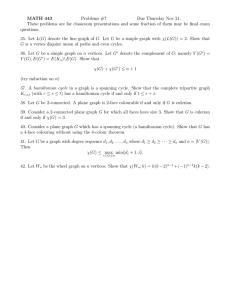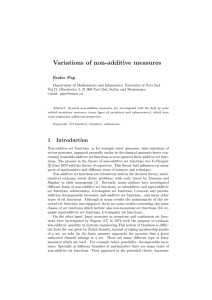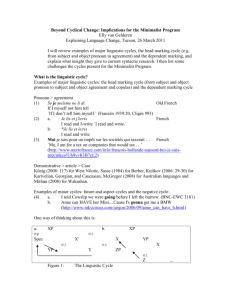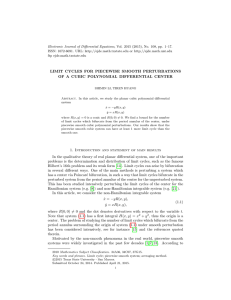Disjoint Cycles and Equitable Colorings in Graphs H. Kierstead A. Kostochka T. Molla
advertisement
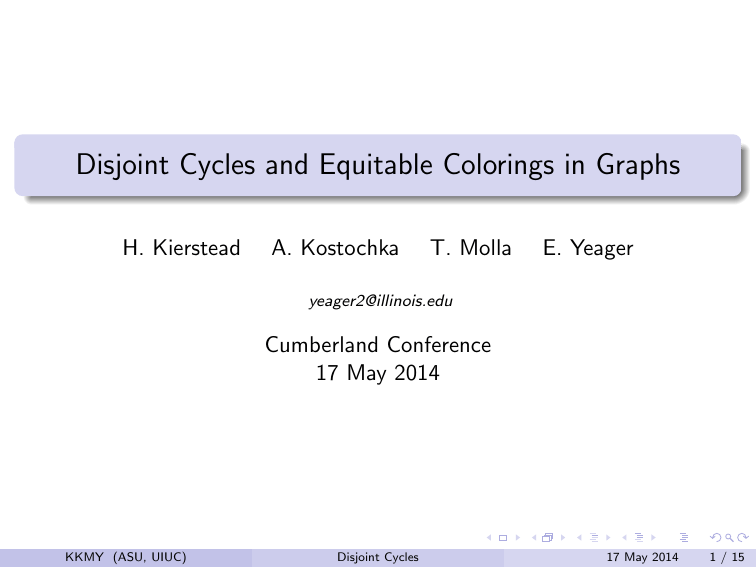
Disjoint Cycles and Equitable Colorings in Graphs
H. Kierstead
A. Kostochka
T. Molla
E. Yeager
yeager2@illinois.edu
Cumberland Conference
17 May 2014
KKMY (ASU, UIUC)
Disjoint Cycles
17 May 2014
1 / 15
Disjoint Cycles
KKMY (ASU, UIUC)
Disjoint Cycles
17 May 2014
2 / 15
Corrádi-Hajnal Theorem
Corrádi-Hajnal, 1963
If G is a graph on n vertices with n ≥ 3k and δ(G ) ≥ 2k, then G contains
k disjoint cycles.
KKMY (ASU, UIUC)
Disjoint Cycles
17 May 2014
3 / 15
Corrádi-Hajnal Theorem
Corrádi-Hajnal, 1963
If G is a graph on n vertices with n ≥ 3k and δ(G ) ≥ 2k, then G contains
k disjoint cycles.
Examples:
k=1
KKMY (ASU, UIUC)
Disjoint Cycles
17 May 2014
3 / 15
Corrádi-Hajnal Theorem
Corrádi-Hajnal, 1963
If G is a graph on n vertices with n ≥ 3k and δ(G ) ≥ 2k, then G contains
k disjoint cycles.
Examples:
k = 1: easy
KKMY (ASU, UIUC)
Disjoint Cycles
17 May 2014
3 / 15
Corrádi-Hajnal Theorem
Corrádi-Hajnal, 1963
If G is a graph on n vertices with n ≥ 3k and δ(G ) ≥ 2k, then G contains
k disjoint cycles.
Examples:
k = 1: easy
Sharpness:
k
k
k
KKMY (ASU, UIUC)
Disjoint Cycles
17 May 2014
3 / 15
Corrádi-Hajnal Theorem
Corrádi-Hajnal, 1963
If G is a graph on n vertices with n ≥ 3k and δ(G ) ≥ 2k, then G contains
k disjoint cycles.
Examples:
k = 1: easy
Sharpness:
k
k
k
KKMY (ASU, UIUC)
2k − 1
Disjoint Cycles
17 May 2014
3 / 15
Enomoto, Wang
Corrádi-Hajnal, 1963
If G is a graph on n vertices with n ≥ 3k and δ(G ) ≥ 2k, then G contains
k disjoint cycles.
KKMY (ASU, UIUC)
Disjoint Cycles
17 May 2014
4 / 15
Enomoto, Wang
Corrádi-Hajnal, 1963
If G is a graph on n vertices with n ≥ 3k and δ(G ) ≥ 2k, then G contains
k disjoint cycles.
σ2 (G ) := min{d(x) + d(y ) : xy 6∈ E (G )}
KKMY (ASU, UIUC)
Disjoint Cycles
17 May 2014
4 / 15
Enomoto, Wang
Corrádi-Hajnal, 1963
If G is a graph on n vertices with n ≥ 3k and δ(G ) ≥ 2k, then G contains
k disjoint cycles.
σ2 (G ) := min{d(x) + d(y ) : xy 6∈ E (G )}
Enomoto 1998, Wang 1999
If G is a graph on n vertices with n ≥ 3k and σ2 (G ) ≥ 4k − 1, then G
contains k disjoint cycles.
KKMY (ASU, UIUC)
Disjoint Cycles
17 May 2014
4 / 15
Enomoto, Wang
Corrádi-Hajnal, 1963
If G is a graph on n vertices with n ≥ 3k and δ(G ) ≥ 2k, then G contains
k disjoint cycles.
σ2 (G ) := min{d(x) + d(y ) : xy 6∈ E (G )}
Enomoto 1998, Wang 1999
If G is a graph on n vertices with n ≥ 3k and σ2 (G ) ≥ 4k − 1, then G
contains k disjoint cycles.
Implies Corrádi-Hajnal
KKMY (ASU, UIUC)
Disjoint Cycles
17 May 2014
4 / 15
Enomoto, Wang
Enomoto 1998, Wang 1999
If G is a graph on n vertices with n ≥ 3k and σ2 (G ) ≥ 4k − 1, then G
contains k disjoint cycles.
KKMY (ASU, UIUC)
Disjoint Cycles
17 May 2014
5 / 15
Enomoto, Wang
Enomoto 1998, Wang 1999
If G is a graph on n vertices with n ≥ 3k and σ2 (G ) ≥ 4k − 1, then G
contains k disjoint cycles.
Sharpness:
k
k
k
KKMY (ASU, UIUC)
2k − 1
Disjoint Cycles
17 May 2014
5 / 15
Enomoto, Wang
Enomoto 1998, Wang 1999
If G is a graph on n vertices with n ≥ 3k and σ2 (G ) ≥ 4k − 1, then G
contains k disjoint cycles.
Proof (Enomoto)
KKMY (ASU, UIUC)
Disjoint Cycles
17 May 2014
5 / 15
Enomoto, Wang
Enomoto 1998, Wang 1999
If G is a graph on n vertices with n ≥ 3k and σ2 (G ) ≥ 4k − 1, then G
contains k disjoint cycles.
Proof (Enomoto)
Edge-maximal counterexample
KKMY (ASU, UIUC)
Disjoint Cycles
17 May 2014
5 / 15
Enomoto, Wang
Enomoto 1998, Wang 1999
If G is a graph on n vertices with n ≥ 3k and σ2 (G ) ≥ 4k − 1, then G
contains k disjoint cycles.
Proof (Enomoto)
Edge-maximal counterexample
I
(k − 1) disjoint cycles
KKMY (ASU, UIUC)
Disjoint Cycles
17 May 2014
5 / 15
Enomoto, Wang
Enomoto 1998, Wang 1999
If G is a graph on n vertices with n ≥ 3k and σ2 (G ) ≥ 4k − 1, then G
contains k disjoint cycles.
Proof (Enomoto)
Edge-maximal counterexample
I
I
(k − 1) disjoint cycles
Remaining graph at least 3 vertices
KKMY (ASU, UIUC)
Disjoint Cycles
17 May 2014
5 / 15
Enomoto, Wang
Enomoto 1998, Wang 1999
If G is a graph on n vertices with n ≥ 3k and σ2 (G ) ≥ 4k − 1, then G
contains k disjoint cycles.
Proof (Enomoto)
Edge-maximal counterexample
I
I
(k − 1) disjoint cycles
Remaining graph at least 3 vertices
Minimize number of vertices in cycles
KKMY (ASU, UIUC)
Disjoint Cycles
17 May 2014
5 / 15
Enomoto, Wang
Enomoto 1998, Wang 1999
If G is a graph on n vertices with n ≥ 3k and σ2 (G ) ≥ 4k − 1, then G
contains k disjoint cycles.
Proof (Enomoto)
Edge-maximal counterexample
I
I
(k − 1) disjoint cycles
Remaining graph at least 3 vertices
Minimize number of vertices in cycles
Maximize longest path in remainder
KKMY (ASU, UIUC)
Disjoint Cycles
17 May 2014
5 / 15
Kierstead-Kostochka-Y, 2014+
Independence Number:
KKMY (ASU, UIUC)
Disjoint Cycles
17 May 2014
6 / 15
Kierstead-Kostochka-Y, 2014+
Independence Number:
Observation:
α(G ) ≥ n − 2k + 1 ⇒ G has no k cycles
KKMY (ASU, UIUC)
Disjoint Cycles
17 May 2014
6 / 15
Kierstead-Kostochka-Y, 2014+
Independence Number:
Observation:
α(G ) ≥ n − 2k + 1 ⇒ G has no k cycles
2k − 1
KKMY (ASU, UIUC)
Disjoint Cycles
17 May 2014
6 / 15
Kierstead-Kostochka-Y, 2014+
Independence Number:
Observation:
α(G ) ≥ n − 2k + 1 ⇒ G has no k cycles
k
k
k
2k − 1
KKMY (ASU, UIUC)
Disjoint Cycles
17 May 2014
6 / 15
Kierstead-Kostochka-Y, 2014+
Independence Number:
Observation:
α(G ) ≥ n − 2k + 1 ⇒ G has no k cycles
Enomoto 1998, Wang 1999
If G is a graph on n vertices with n ≥ 3k and σ2 (G ) ≥ 4k − 1, then G
contains k disjoint cycles.
KKMY (ASU, UIUC)
Disjoint Cycles
17 May 2014
6 / 15
Kierstead-Kostochka-Y, 2014+
Independence Number:
Observation:
α(G ) ≥ n − 2k + 1 ⇒ G has no k cycles
Enomoto 1998, Wang 1999
If G is a graph on n vertices with n ≥ 3k and σ2 (G ) ≥ 4k − 1, then G
contains k disjoint cycles.
KKY, 2014+
For k ≥ 4, if G is a graph on n vertices with n ≥ 3k + 1 and
σ2 (G ) ≥ 4k − 3, then G contains k disjoint cycles if and only if
α(G ) ≤ n − 2k.
KKMY (ASU, UIUC)
Disjoint Cycles
17 May 2014
6 / 15
Kierstead-Kostochka-Y, 2014+
KKY, 2014+
For k ≥ 4, if G is a graph on n vertices with n ≥ 3k + 1 and
σ2 (G ) ≥ 4k − 3, then G contains k disjoint cycles if and only if
α(G ) ≤ n − 2k.
KKMY (ASU, UIUC)
Disjoint Cycles
17 May 2014
7 / 15
Kierstead-Kostochka-Y, 2014+
KKY, 2014+
For k ≥ 4, if G is a graph on n vertices with n ≥ 3k + 1 and
σ2 (G ) ≥ 4k − 3, then G contains k disjoint cycles if and only if
α(G ) ≤ n − 2k.
n ≥ 3k + 1
k
k
k
KKMY (ASU, UIUC)
2k − 1
Disjoint Cycles
k
17 May 2014
7 / 15
Kierstead-Kostochka-Y, 2014+
KKY, 2014+
For k ≥ 4, if G is a graph on n vertices with n ≥ 3k + 1 and
σ2 (G ) ≥ 4k − 3, then G contains k disjoint cycles if and only if
α(G ) ≤ n − 2k.
k = 1:
KKMY (ASU, UIUC)
Disjoint Cycles
17 May 2014
7 / 15
Kierstead-Kostochka-Y, 2014+
KKY, 2014+
For k ≥ 4, if G is a graph on n vertices with n ≥ 3k + 1 and
σ2 (G ) ≥ 4k − 3, then G contains k disjoint cycles if and only if
α(G ) ≤ n − 2k.
k = 2:
u
KKMY (ASU, UIUC)
Disjoint Cycles
17 May 2014
v
7 / 15
Kierstead-Kostochka-Y, 2014+
KKY, 2014+
For k ≥ 4, if G is a graph on n vertices with n ≥ 3k + 1 and
σ2 (G ) ≥ 4k − 3, then G contains k disjoint cycles if and only if
α(G ) ≤ n − 2k.
k = 3:
KKMY (ASU, UIUC)
Disjoint Cycles
17 May 2014
7 / 15
Kierstead-Kostochka-Y, 2014+
KKY, 2014+
For k ≥ 4, if G is a graph on n vertices with n ≥ 3k + 1 and
σ2 (G ) ≥ 4k − 3, then G contains k disjoint cycles if and only if
α(G ) ≤ n − 2k.
σ2 = 4k − 4:
k−3
2r
k+1
K2t
k+3
KKMY (ASU, UIUC)
Disjoint Cycles
2r − 2
17 May 2014
7 / 15
Kierstead-Kostochka-Y, 2014+
KKY, 2014+
For k ≥ 4, if G is a graph on n vertices with n ≥ 3k + 1 and
σ2 (G ) ≥ 4k − 3, then G contains k disjoint cycles if and only if
α(G ) ≤ n − 2k.
Proof
(Like Enomoto)
Let G be an edge-maximal counterexample.
There exists a set of (k − 1) disjoint cycles.
Choose the set of cycles with the least number of vertices, etc.
KKMY (ASU, UIUC)
Disjoint Cycles
17 May 2014
7 / 15
Dirac: (2k − 1)-connected without k disjoint cycles
Dirac, 1963
What (2k − 1)-connected graphs do not have k disjoint cycles?
KKMY (ASU, UIUC)
Disjoint Cycles
17 May 2014
8 / 15
Dirac: (2k − 1)-connected without k disjoint cycles
Dirac, 1963
What (2k − 1)-connected graphs do not have k disjoint cycles?
Observation:
G is (2k − 1) connected ⇒
KKMY (ASU, UIUC)
Disjoint Cycles
17 May 2014
8 / 15
Dirac: (2k − 1)-connected without k disjoint cycles
Dirac, 1963
What (2k − 1)-connected graphs do not have k disjoint cycles?
Observation:
G is (2k − 1) connected ⇒ δ(G ) ≥ 2k − 1⇒
KKMY (ASU, UIUC)
Disjoint Cycles
17 May 2014
8 / 15
Dirac: (2k − 1)-connected without k disjoint cycles
Dirac, 1963
What (2k − 1)-connected graphs do not have k disjoint cycles?
Observation:
G is (2k − 1) connected ⇒ δ(G ) ≥ 2k − 1⇒ σ2 (G ) ≥ 4k − 2
KKMY (ASU, UIUC)
Disjoint Cycles
17 May 2014
8 / 15
Dirac: (2k − 1)-connected without k disjoint cycles
Dirac, 1963
What (2k − 1)-connected graphs do not have k disjoint cycles?
Observation:
G is (2k − 1) connected ⇒ δ(G ) ≥ 2k − 1⇒ σ2 (G ) ≥ 4k − 2
KKY, 2014+
For k ≥ 4, if G is a graph on n vertices with n ≥ 3k + 1 and
σ2 (G ) ≥ 4k − 3, then G contains k disjoint cycles if and only if
α(G ) ≤ n − 2k.
KKMY (ASU, UIUC)
Disjoint Cycles
17 May 2014
8 / 15
Dirac: (2k − 1)-connected without k disjoint cycles
KKY, 2014+
For k ≥ 4, if G is a graph on n vertices with n ≥ 3k + 1 and
σ2 (G ) ≥ 4k − 3, then G contains k disjoint cycles if and only if
α(G ) ≤ n − 2k.
Answer to Dirac’s Question
Let k ≥ 2. Every graph G with (i) |G | ≥ 3k and (ii) δ(G ) ≥ 2k − 1
contains k disjoint cycles if and only if
α(G ) ≤ |G | − 2k, and
if k is odd and |G | = 3k, then G 6= 2Kk ∨ Kk , and
if k = 2 then G is not a wheel.
KKMY (ASU, UIUC)
Disjoint Cycles
17 May 2014
8 / 15
Dirac: (2k − 1)-connected without k disjoint cycles
KKY, 2014+
For k ≥ 4, if G is a graph on n vertices with n ≥ 3k + 1 and
σ2 (G ) ≥ 4k − 3, then G contains k disjoint cycles if and only if
α(G ) ≤ n − 2k.
Answer to Dirac’s Question
Let k ≥ 2. Every graph G with (i) |G | ≥ 3k and (ii) δ(G ) ≥ 2k − 1
contains k disjoint cycles if and only if
α(G ) ≤ |G | − 2k, and
if k is odd and |G | = 3k, then G 6= 2Kk ∨ Kk , and
if k = 2 then G is not a wheel.
Further:
KKMY (ASU, UIUC)
Disjoint Cycles
17 May 2014
8 / 15
Dirac: (2k − 1)-connected without k disjoint cycles
KKY, 2014+
For k ≥ 4, if G is a graph on n vertices with n ≥ 3k + 1 and
σ2 (G ) ≥ 4k − 3, then G contains k disjoint cycles if and only if
α(G ) ≤ n − 2k.
Answer to Dirac’s Question
Let k ≥ 2. Every graph G with (i) |G | ≥ 3k and (ii) δ(G ) ≥ 2k − 1
contains k disjoint cycles if and only if
α(G ) ≤ |G | − 2k, and
if k is odd and |G | = 3k, then G 6= 2Kk ∨ Kk , and
if k = 2 then G is not a wheel.
Further:
characterization for multigraphs
KKMY (ASU, UIUC)
Disjoint Cycles
17 May 2014
8 / 15
Equitable Coloring
KKMY (ASU, UIUC)
Disjoint Cycles
17 May 2014
9 / 15
Equitable Coloring
Definition
An equitable k-coloring of a graph G is a proper coloring of V (G ) such
that any two color classes differ in size by at most one.
KKMY (ASU, UIUC)
Disjoint Cycles
17 May 2014
10 / 15
Equitable Coloring
Definition
An equitable k-coloring of a graph G is a proper coloring of V (G ) such
that any two color classes differ in size by at most one.
KKMY (ASU, UIUC)
Disjoint Cycles
17 May 2014
10 / 15
Equitable Coloring
Definition
An equitable k-coloring of a graph G is a proper coloring of V (G ) such
that any two color classes differ in size by at most one.
KKMY (ASU, UIUC)
Disjoint Cycles
17 May 2014
10 / 15
Equitable Coloring
Definition
An equitable k-coloring of a graph G is a proper coloring of V (G ) such
that any two color classes differ in size by at most one.
KKMY (ASU, UIUC)
Disjoint Cycles
17 May 2014
10 / 15
Equitable Coloring
Definition
An equitable k-coloring of a graph G is a proper coloring of V (G ) such
that any two color classes differ in size by at most one.
KKMY (ASU, UIUC)
Disjoint Cycles
17 May 2014
10 / 15
Equitable Coloring and Cycles
n = 3k
If G has n = 3k vertices, then G has an equitable k-coloring if and only if
G has k disjoint cycles (all triangles).
KKMY (ASU, UIUC)
Disjoint Cycles
17 May 2014
11 / 15
Equitable Coloring and Cycles
n = 3k
If G has n = 3k vertices, then G has an equitable k-coloring if and only if
G has k disjoint cycles (all triangles).
KKMY (ASU, UIUC)
Disjoint Cycles
17 May 2014
11 / 15
Equitable Coloring and Cycles
n = 3k
If G has n = 3k vertices, then G has an equitable k-coloring if and only if
G has k disjoint cycles (all triangles).
KKMY (ASU, UIUC)
Disjoint Cycles
17 May 2014
11 / 15
Equitable Coloring and Cycles
n = 3k
If G has n = 3k vertices, then G has an equitable k-coloring if and only if
G has k disjoint cycles (all triangles).
What’s Really Going On
independent sets ↔ cliques
KKMY (ASU, UIUC)
Disjoint Cycles
17 May 2014
11 / 15
Chen-Lih-Wu
Hajnal-Szemerédi, 1970
If k ≥ ∆(G ) + 1, then G is equitably k-colorable.
KKMY (ASU, UIUC)
Disjoint Cycles
17 May 2014
12 / 15
Chen-Lih-Wu
Hajnal-Szemerédi, 1970
If k ≥ ∆(G ) + 1, then G is equitably k-colorable.
Chen-Lih-Wu Conjecture
If χ(G ), ∆(G ) ≤ k, and if Kk,k 6⊆ G when k is odd,
then G is equitably k-colorable.
KKMY (ASU, UIUC)
Disjoint Cycles
17 May 2014
12 / 15
Chen-Lih-Wu
Hajnal-Szemerédi, 1970
If k ≥ ∆(G ) + 1, then G is equitably k-colorable.
Chen-Lih-Wu Conjecture
If χ(G ), ∆(G ) ≤ k, and if Kk,k 6⊆ G when k is odd,
then G is equitably k-colorable.
CLW true if:
δ(G ) ≥ |G |/2; ∆(G ) ≤ 4; G planar with ∆(G ) ≥ 13; G outerplanar, etc.
KKMY (ASU, UIUC)
Disjoint Cycles
17 May 2014
12 / 15
Ore Conditions
Chen-Lih-Wu Conjecture
If χ(G ), ∆(G ) ≤ k and Kk,k 6⊆ G , then G is equitably k-colorable.
KKMY (ASU, UIUC)
Disjoint Cycles
17 May 2014
13 / 15
Ore Conditions
Chen-Lih-Wu Conjecture
If χ(G ), ∆(G ) ≤ k and Kk,k 6⊆ G , then G is equitably k-colorable.
Kierstead-Kostochka-Molla-Y, 2014+
If G is a k-colorable 3k-vertex graph such that for each edge xy ,
d(x) + d(y ) ≤ 2k + 1, then G is equitably k-colorable, or is one of several
exceptions.
KKMY (ASU, UIUC)
Disjoint Cycles
17 May 2014
13 / 15
Ore Conditions
Chen-Lih-Wu Conjecture
If χ(G ), ∆(G ) ≤ k and Kk,k 6⊆ G , then G is equitably k-colorable.
Kierstead-Kostochka-Molla-Y, 2014+
If G is a k-colorable 3k-vertex graph such that for each edge xy ,
d(x) + d(y ) ≤ 2k + 1, then G is equitably k-colorable, or is one of several
exceptions.
Equivalent
If G is a graph on 3k vertices with σ2 (G ) ≥ 4k − 3, then G contains k
disjoint cycles, or is one of several exceptions, or G is not k-colorable.
KKMY (ASU, UIUC)
Disjoint Cycles
17 May 2014
13 / 15
Ore Conditions
Kierstead-Kostochka-Molla-Y, 2014+
If G is a k-colorable 3k-vertex graph such that for each edge xy ,
d(x) + d(y ) ≤ 2k + 1, then G is equitably k-colorable, or is one of several
exceptions.
Equivalent
If G is a graph on 3k vertices with σ2 (G ) ≥ 4k − 3, then G contains k
disjoint cycles, or is one of several exceptions, or G is not k-colorable.
KKY, 2014+
For k ≥ 4, if G is a graph on n vertices with n ≥ 3k + 1 and
σ2 (G ) ≥ 4k − 3, then G contains k disjoint cycles if and only if
α(G ) ≤ n − 2k.
KKMY (ASU, UIUC)
Disjoint Cycles
17 May 2014
13 / 15
Exceptions
k=3
Equitable coloring:
Cycles:
KKMY (ASU, UIUC)
Disjoint Cycles
17 May 2014
14 / 15
Exceptions
Equitable coloring:
c
Kk
2k − c
Cycles:
k
k
k
KKMY (ASU, UIUC)
Disjoint Cycles
17 May 2014
14 / 15
Exceptions
Equitable coloring:
Kk−1
2k
Cycles:
K2k
KKMY (ASU, UIUC)
k−1
Disjoint Cycles
17 May 2014
14 / 15
Thanks for Listening!
KKMY (ASU, UIUC)
Disjoint Cycles
17 May 2014
15 / 15


